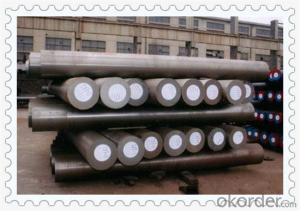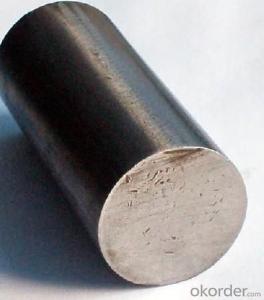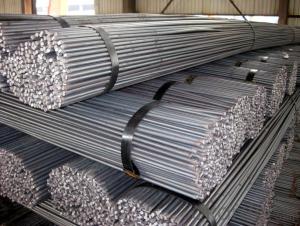SCM440 SCM415 SAE4140 Steel Round Bar /AISI 4140 Steel
- Loading Port:
- China main port
- Payment Terms:
- TT OR LC
- Min Order Qty:
- 5 m.t.
- Supply Capability:
- 100000 m.t./month
OKorder Service Pledge
OKorder Financial Service
You Might Also Like
Item specifice
SCM440 SCM415 SAE4140 Steel Round Bar /AISI 4140 Steels
1. Dia:12mm-300mm
2. Standard Performed: ASTM A29/A29M-04
3. Equal Standard:
America Standard: AISI4140
International Standard: 42CrMo4
Japan Standard: SCM440
Germany Standard: 42CrMo4
4. Chemical composition:
Grade | C | Si | Mn | P | S | Ni | Cr | Mo | Cu | Al |
AISI4140 | 0.38 0.41 | 0.15 0.35 | 0.85 1.00 | Max 0.015 | Max 0.040 | Max 0.25 | 0.80 1.10 | 0.15 0.25 | Max 0.35 | 0.012 0.030 |
5. Grade: ASTM A29 4140 42CrMo SCM440
Hardness:217HB
Tensile strength:1080(110)MPA
Yield strength: 930(95)MPA
Elogation: 12%
Reduction of area: 45%
AKV(impact value): 63J
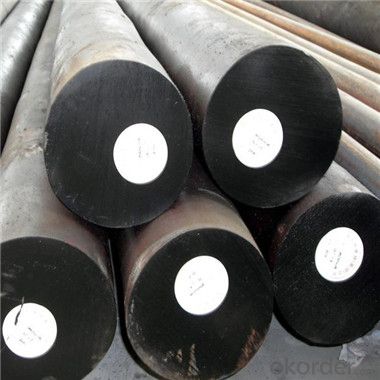
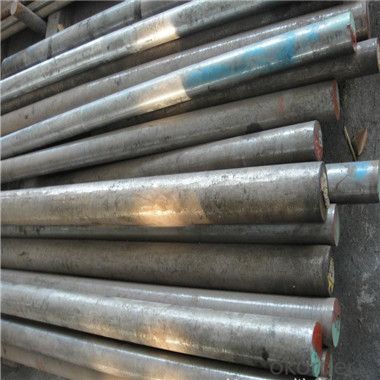
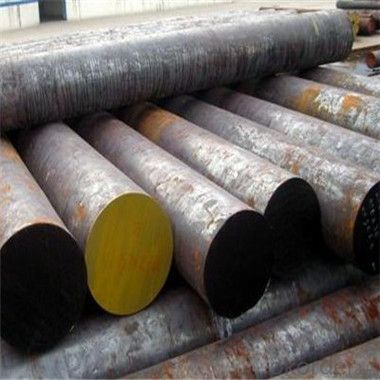
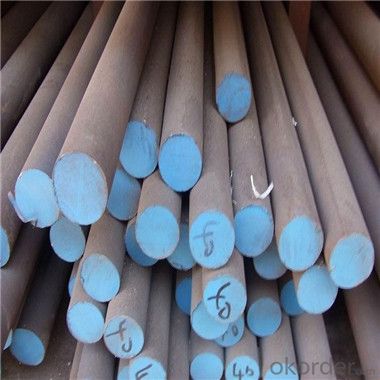
- Q:Can steel round bars be used in the manufacturing of garden tools?
- Yes, steel round bars can be used in the manufacturing of garden tools. Steel is a durable and robust material that offers strength and resistance, making it suitable for various garden tools such as shovels, rakes, hoes, and spades. The round bars can be shaped and formed to create the desired tool design and functionality, ensuring durability and longevity in outdoor conditions.
- Q:What is the tensile strength of Q235 round steel?
- Level 1, surface shape, light circle, strength code R235, grade Q235, carbon content 0.14%-0.22%. Silicon content 0.12%-0.30%. Manganese content 0.30%-0.65%, phosphorus content is equal to less than 0.045%, sulfur content is less than or equal to 0.050%,
- Q:What are the different surface hardness options for steel round bars?
- Steel round bars can exhibit varying degrees of surface hardness, depending on the specific requirements and applications. There are several options available for achieving different levels of surface hardness in steel round bars: 1. Soft or annealed: At the lowest end of the surface hardness spectrum, steel is subjected to a heating and gradual cooling process to reduce internal stress and enhance ductility. Soft or annealed steel is easier to machine and shape, but it possesses lower strength and wear resistance. 2. Normalized: By heating steel to a predetermined temperature and subsequently cooling it in ambient air, the grain structure is refined, resulting in improved mechanical properties and increased hardness compared to annealed steel. 3. Quenched and tempered: This heat treatment process involves heating steel to high temperatures and quickly cooling it in a quenching medium like oil or water. The rapid cooling hardens the steel's surface, while the subsequent tempering process alleviates internal stresses and enhances toughness. Quenched and tempered steel round bars exhibit high levels of hardness and strength, making them suitable for applications requiring resistance to wear and impact. 4. Induction hardened: Through induction hardening, the surface of a steel round bar is selectively heated using an induction coil. This localized heating is followed by rapid quenching, resulting in a hardened surface layer that exhibits increased wear resistance. The core of the steel remains unaffected, retaining its toughness. 5. Case hardened: Also known as carburizing, case hardening involves introducing carbon into the surface layer of the steel round bar. This can be achieved by exposing the steel to a carbon-rich gas or heating it with a carbon-containing material. The carbon diffuses into the surface, increasing its hardness while leaving the core relatively softer. Case hardened steel round bars possess a tough core with a wear-resistant surface. These examples represent only a fraction of the available surface hardness options for steel round bars. The choice of hardness depends on specific application requirements such as required strength, wear resistance, and toughness.
- Q:How are steel round bars used in the manufacturing of heat exchangers?
- Steel round bars are commonly used in the manufacturing of heat exchangers due to their unique properties that make them suitable for this application. Heat exchangers are devices that transfer heat between two or more fluids, and steel round bars play a crucial role in their construction. One major use of steel round bars in heat exchangers is for the fabrication of the heat exchanger tubes. These tubes are responsible for carrying the fluids that need to be heated or cooled. Steel round bars are often used as the base material for these tubes due to their high strength and excellent heat transfer properties. The round shape of the bars allows for easy fabrication of the tubes, ensuring a tight and secure fit. Additionally, steel round bars are used to construct the headers and tube sheets of heat exchangers. The headers are the component that allows the fluid to enter and exit the heat exchanger, while the tube sheets hold the tubes in place. These components require high strength and durability to withstand the pressure and temperature differentials that occur during heat exchange. Steel round bars provide the necessary strength and stability to ensure the proper functioning of the heat exchanger. Furthermore, steel round bars are also used in the manufacturing of the support structures or frames of heat exchangers. These structures provide stability and support to the heat exchanger components and ensure proper alignment and positioning. Steel round bars offer excellent structural integrity and can withstand heavy loads, making them ideal for this purpose. In conclusion, steel round bars are an integral component in the manufacturing of heat exchangers. Their high strength, excellent heat transfer properties, and durability make them suitable for fabricating the tubes, headers, tube sheets, and support structures of heat exchangers. By utilizing steel round bars, manufacturers can ensure the efficiency, effectiveness, and longevity of heat exchangers in various industries, such as power generation, chemical processing, and HVAC systems.
- Q:What are the different types of steel round bar surface finishes used in the construction industry?
- Steel round bars are widely used in the construction industry due to their strength and durability. To meet specific requirements and enhance performance, these bars undergo various surface finishes. Some common surface finishes used in construction include: 1. Hot Rolled Finish: The most commonly used finish involves heating the steel bar above its recrystallization temperature and rolling it through rollers. This process creates a rough and scale-covered surface. 2. Cold Drawn Finish: This process involves drawing the steel bar through dies to reduce its diameter and increase its length. Cold drawing produces a smooth and shiny surface, ideal for applications where aesthetics and precision are important. 3. Peeled and Polished Finish: This finish includes removing the outer layer of the steel bar through peeling and polishing it to achieve a smooth and mirror-like surface. It is often used in applications that require high visual appeal, such as architectural structures or decorative elements. 4. Ground Finish: Grinding is used to achieve a smooth and uniform surface finish on steel round bars. The process removes imperfections and unevenness, resulting in a precise and polished surface. Ground finishes are commonly used in applications that require tight tolerances, such as machinery or automotive components. 5. Coated Finish: Steel round bars can be coated with various materials, such as galvanized, epoxy, or powder coatings, to enhance corrosion resistance and provide additional properties. These coatings not only protect the steel from environmental factors but also improve its aesthetic appeal. Each surface finish offers unique advantages and is chosen based on specific project requirements. Whether it's for aesthetics, corrosion resistance, or tolerances, selecting the right surface finish is crucial to ensure optimal performance of steel round bars in their intended applications.
- Q:What are the advantages of using niobium-alloy steel round bars?
- There are several advantages of using niobium-alloy steel round bars. Firstly, niobium improves the strength and toughness of the steel, making it highly durable and resistant to fatigue and wear. Secondly, the alloy's high temperature stability allows for its use in extreme conditions without compromising its structural integrity. Additionally, niobium-alloy steel round bars offer excellent corrosion resistance, making them suitable for applications in harsh environments. Lastly, the alloy's lightweight nature makes it ideal for industries that require strong yet lightweight materials, such as aerospace and automotive sectors.
- Q:What are the advantages of using precipitation-strengthened steel round bars?
- Using precipitation-strengthened steel round bars in various applications offers several benefits. Firstly, these bars possess improved mechanical properties, making them stronger and more durable compared to regular steel bars. Through the heat treatment process of precipitation hardening, fine particles form within the steel structure. These particles act as obstacles to dislocation movement, resulting in enhanced strength and hardness. Secondly, the increased strength of precipitation-strengthened steel round bars allows for material usage reduction while maintaining the desired level of structural integrity. This leads to cost savings in terms of raw materials and transportation, making it an economical choice in the construction and manufacturing industries. Additionally, precipitation-strengthened steel round bars exhibit excellent corrosion resistance properties. The formation of fine particles during precipitation hardening creates a dense and uniform microstructure, effectively blocking the movement of corrosive agents. This corrosion resistance makes these bars ideal for applications in harsh environments or industries where exposure to corrosive substances is common. Another advantage of using precipitation-strengthened steel round bars is their ability to withstand high temperatures. The fine particles within the steel structure contribute to improved thermal stability, enabling these bars to maintain their strength and hardness even under elevated temperatures. This makes them suitable for applications involving high-temperature operations, such as in the aerospace and automotive industries. Furthermore, precipitation-strengthened steel round bars possess superior fatigue resistance, making them advantageous in applications that require repetitive or cyclic loading. The precipitation hardening process enhances the material's resistance to fatigue failure, allowing it to withstand prolonged stress without significant deformation or failure. This makes these bars suitable for use in structures subjected to dynamic or fluctuating loads, such as bridges, cranes, and machinery components. In conclusion, precipitation-strengthened steel round bars offer enhanced mechanical properties, reduced material usage, excellent corrosion resistance, high-temperature stability, and superior fatigue resistance. These advantages make them the preferred choice for a wide range of applications, spanning from construction and manufacturing to the aerospace and automotive industries.
- Q:What are the different cutting methods for steel round bars?
- There are several different cutting methods that can be used for steel round bars, depending on the specific requirements and equipment available. Some of the most common cutting methods include: 1. Sawing: This is one of the most basic and traditional methods of cutting steel round bars. It involves using a saw blade with teeth to cut through the metal. Sawing can be done manually with a hacksaw or powered by using a bandsaw or circular saw. It is a versatile method that can be used for both small-scale and large-scale cutting projects. 2. Shearing: Shearing is another common method of cutting steel round bars. It involves using a shear machine or hydraulic press to apply a high amount of force to cut the metal. This method is often used for cutting thick or heavy-duty steel bars. 3. Abrasive cutting: Abrasive cutting involves the use of an abrasive wheel or disc to grind away the metal and create a cut. This method is commonly used for cutting steel round bars with irregular shapes or for precision cutting projects. It can be done manually with a handheld grinder or using a machine like an abrasive cut-off saw. 4. Flame cutting: Flame cutting, also known as oxy-fuel cutting, uses a combination of oxygen and a fuel gas (such as acetylene or propane) to create a high-temperature flame that melts and cuts through the steel. This method is often used for cutting thick steel bars or for shaping metal. 5. Plasma cutting: Plasma cutting is a more advanced method that uses a plasma torch to cut through the steel. The plasma torch generates a high-velocity jet of ionized gas that melts and removes the metal. This method is commonly used for precision cutting, as it allows for greater control and produces cleaner cuts compared to other methods. It is important to note that the choice of cutting method will depend on factors such as the thickness and hardness of the steel round bar, the desired precision of the cut, and the available equipment and resources. It is recommended to consult with a professional or experienced metalworker to determine the most appropriate cutting method for a specific project.
- Q:How do you measure the diameter of a steel round bar?
- To measure the diameter of a steel round bar, you can use a caliper or a micrometer. First, ensure that the round bar is clean and free from any debris or rough edges. Place the round bar on a flat surface. If you have a caliper, open it and position one jaw on one side of the round bar and the other jaw on the opposite side. Make sure that the jaws are aligned perpendicular to the bar and are in contact with the outer surface. Gently close the caliper until both jaws are firmly against the bar. Read the measurement on the caliper's scale or digital display. This will give you the diameter of the round bar. Alternatively, if you have a micrometer, open it and set the thimble to zero. Position the anvil (stationary part) against one side of the round bar and the spindle (moving part) against the opposite side. Rotate the thimble until the spindle firmly contacts the bar. Read the measurement on the thimble's scale or digital display along with the corresponding number on the barrel. This will give you the diameter of the round bar. Remember to take multiple measurements at various points along the bar to ensure accuracy, as the round bar might not have a perfectly uniform diameter throughout its length.
- Q:Can steel round bars be used for valve stem applications?
- Yes, steel round bars can be used for valve stem applications. Steel round bars are often used in various industrial applications, including valve stems, due to their strength, durability, and resistance to corrosion.
1. Manufacturer Overview |
|
|---|---|
| Location | |
| Year Established | |
| Annual Output Value | |
| Main Markets | |
| Company Certifications | |
2. Manufacturer Certificates |
|
|---|---|
| a) Certification Name | |
| Range | |
| Reference | |
| Validity Period | |
3. Manufacturer Capability |
|
|---|---|
| a)Trade Capacity | |
| Nearest Port | |
| Export Percentage | |
| No.of Employees in Trade Department | |
| Language Spoken: | |
| b)Factory Information | |
| Factory Size: | |
| No. of Production Lines | |
| Contract Manufacturing | |
| Product Price Range | |
Send your message to us
SCM440 SCM415 SAE4140 Steel Round Bar /AISI 4140 Steel
- Loading Port:
- China main port
- Payment Terms:
- TT OR LC
- Min Order Qty:
- 5 m.t.
- Supply Capability:
- 100000 m.t./month
OKorder Service Pledge
OKorder Financial Service
Similar products
New products
Hot products
Related keywords
